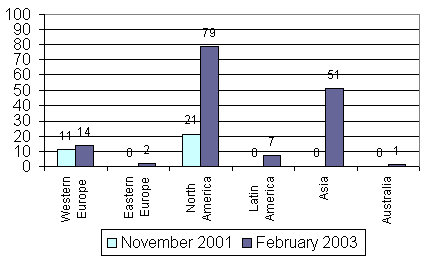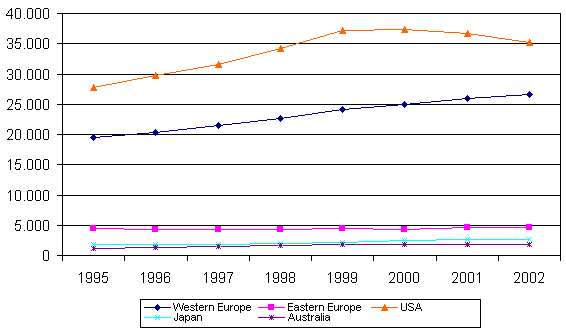|
THE SLOW GROWTH OF DIGITAL CINEMA
Talk by Elisabetta Brunella
Secretary General of MEDIA Salles
Workshop:
"New possibilities and challenges arising from new technologies
for the circulation of European cinema and the fight
against piracy"
Venice, 30 August 2003
On opening this workshop session devoted
specifically to digital cinema, I bring you greetings from Jens Rykaer,
President of MEDIA Salles, who is unable to be here with us as the European
Film College, of which he is Director, is celebrating its 10th anniversary
today.
As you know, MEDIA Salles was created in 1991,
in the framework of the then brand-new MEDIA Programme and with the support
of the Italian Government, in order to address exhibitors and to promote
European films in cinemas.
One of the best-known of MEDIA Salles' initiatives is the "European Cinema
Yearbook" which has been collecting data on cinema-going in 32 European
countries since 1989.
As well as an analysis of basic indicators, such as tickets sold, box
office, average pro-capita admissions, number of screens and seats, market
shares of films according to their nationality, MEDIA Salles decided to
devote special sections of the Yearbook to those phenonema which have
influenced and continue to influence the structural transformation of
cinema exhibition, the cinema-going habits of audiences and, more in general,
the economy of the cinema exhibition industry.
For this reason, for some years now the Yearbook has been reporting on
the situation of multiplexes throughout Europe (according to the practice
adopted by MEDIA Salles, this means complexes with at least 8 screens),
whilst the most recent edition - the eleventh - has a section devoted
to digital cinema.
This decision is underpinned by the desire to offer precise data to support
evaluation and debate involving operators and companies both inside and
outside the cinema industry on the development and adoption of digital
technology for the production and distribution of films.
In line with this approach, the aim of my talk today is to provide you
with a statistical framework for discussion concerning the digitalisation
of cinemas.
We can see immediately how many screens were equipped for digital screening
at the beginning of this year and where they are located.
In recording this data we have taken as our basis the screens that have
adopted the DLP CinemaTM technology produced by Texas Instruments.
There proves to be a total of 154 of these screens, 79 of which are distributed
through North America, 7 in Latin America, 16 in Europe, 51 in Asia and
1 in Australia.
Let us compare the 2003 data with the figures recorded at the end of 2001.
TABLE 1: DIGITAL SCREENS
WORLDWIDE (with DLP CinemaTM Technology produced by Texas Instruments)
| |
November 2001 |
February 2003 |
Var. % 2003/2001 |
| Western Europe |
11
|
14
|
+27%
|
| Eastern Europe |
.
|
2
|
.
|
| North America |
21
|
79
|
+276%
|
| Latin America |
.
|
7
|
.
|
| Asia |
8
|
51
|
+538%
|
| Australia |
.
|
1
|
.
|
| TOTAL |
32
|
154
|
+381%
|
From this comparison some interesting observations emerge:
- in the space of one and a half years there has only been a slight
increase in the number of digital screens in Western Europe
- digital screening has also made an entry - for the moment a decidedly
timid one - into Eastern Europe, Australia and Latin America
- North America has seen the numbers of its digital cinemas increase
fourfold
- Asia, and in particular China, where 34 of the Continent's screens
are located, has shown signs of confidence in this new technology
GRAPH. 1: DIGITAL SCREENS WORLDWIDE (with DLP
CinemaTM Technology produced by Texas Instruments)

In general an attitude of extreme prudence
can be observed on the part of the exhibitors. Indeed, if we examine the
trend in the number of "conventional" screens, it can be seen, for example,
that in Western Europe the past few years have seen significant investments
resulting in a considerable increase in numbers.
Over a seven-year period there has, in fact, been a 36% rise in the number
of screens.
TABLE 2: TOTAL SCREENS WORLDWIDE
| |
1995
|
1996
|
1997
|
1998
|
1999
|
2000
|
2001
|
2002
|
Var. %
95/02
|
Var.%
2000/02
|
| Western Europe |
19.583
|
20.366
|
21.483
|
|
24.055
|
24.982
|
25.932
|
26.645
|
+36%
|
+6.6%
|
| Eastern Europe |
4.497
|
4.232
|
4.276
|
4.258
|
4.452
|
4.379
|
4.701
|
4.657
|
+4%
|
+6.3%
|
| USA |
27.805
|
29.690
|
31.640
|
34.186
|
37.185
|
37.396
|
36.764
|
35.280
|
+27%
|
-5.7%
|
| Japan |
1.776
|
1.828
|
1.884
|
1.993
|
2.230
|
2.524
|
2.585
|
2.635
|
+48%
|
+4.4%
|
| Australia |
1.137
|
1.251
|
1.431
|
1.576
|
1.748
|
1.817
|
1.855
|
1.872
|
+65%
|
+3%
|
GRAPH. 2: TOTAL SCREEN WORLDWIDE

The same confidence does not seem to be evident,
at least for the moment, in the field of digital cinema.
Turning our attention to North America, the
situation seems to be the exact opposite, i.e. marked by an overall reduction
in the number of screens in the United States, starting from 2001, and
by a flattering growth in digital screens, in terms of percentage variation,
as they increase almost fourfold in just a year and a half. Yet here,
too, this growth has proved to be far smaller that the prospects that
seemed to have been opened up by the release of Star Wars: Episode II
in digital format, in May 2002. It was, in fact, generally believed that
following this event, there would be one thousand digital screens available
in the United States.
Here, too, caution seems to have prevailed.
One of the reasons for this attitude may be found in the difficulties
of obtaining digital films, difficulties which only partly emerge from
the statistics regarding the number of films distributed with DLP CinemaTM
technology.
There were 4 of these in 1999, 12 in 2000, 18 in 2001, 3 in the first
two months of 2003.
TABLE 3: DIGITAL FILMS
WORLDWIDE (with DLP CinemaTM Technology produced by Texas Instruments)
| |
1999 |
2000 |
2001 |
2002 |
2003
(first 2 months) |
| Number of films |
4
|
12
|
18
|
20
|
3
|
At a first reading these figures indicate growth. However, this increase
has not affected all markets: in fact some films were only available for
digital screening in one, or very few, territories and did not experience
truly international circulation.
The case of films that were distributed analogically worldwide but only
available in an English-language version for digital screening is significant.
This particular element can, at least partly, offer an explanation for
the stalemate in the situation of digital screens in Western Europe.
Observing the origin of films made available for digital screening, it
can also be seen that the vast majority come from the United States and
that Europe, a territory that is comparable to the United States in terms
of production capacity, has only played a marginal role in this field
up to now.
TABLE 4: DIGITAL FILMS WORLDWIDE (with DLP
CinemaTM Technology produced by Texas Instruments)
|
NOVEMBER 2001
|
|
FEBRUARY 2003
|
|
|
32
|
|
57
|
|
|
of which:
|
%
|
of which:
|
%
|
|
27 produced in the US
|
84.4%
|
46 produced in the US
|
80.7%
|
|
4 produced in Japan
|
12.5%
|
6 produced in Japan
|
10.6%
|
|
1 produced in France
|
3.1%
|
3 produced in China
|
5.3%
|
|
|
|
1 produced in France
|
1.7%
|
|
|
|
1 produced inItaly
|
1.7%
|
To sum up:
- digital screens are spreading very slowly, certainly more slowly
than was predicted;
- the forecasts predicting that 5% of all screens in the United States
would be digital by 2004 have proved unrealistic;
- the cost of equipping a cinema with a digital screen is still in the
region of 100,000 euros, a sum that is a long way from that estimated
by economic analyses of the sector for digital screening to become competitive
with respect to analogical screening (50,000 euros);
- The supply of films in digital format is still scarce and irregular.
These factors mean that digital screening remains in an experimental
phase.
Combining the data deriving from statistical surveys and the information
emerging from professional meetings with exhibitors on the topic of digital
cinema organised both by MEDIA Salles and by other bodies, as well as
the results of audience surveys (e.g. the one recently published by Screen
Digest on digital cinemas in California or that carried out in Italy at
the Arcadia cinema in Melzo), it can be seen that the experimental phase
has highlighted some points of vital importance for the future of digital
screening:
- a positive view of digital technology by audiences
- increased confidence in the ability of the technology to provide
visual quality comparable to that obtained on conventional film, particularly
in view of the fact that the quality of digital screening remains constant
through time
- concern that the introduction of digital technology may modify existing
business patterns, as well as the roles and the equilibrium of the various
different operators involved in the process of the film's life
- the question of the effects on the general public of the benefits
foreseen from digital screening at the level of distribution (lower
costs and greater flexibility). Will the benefits expected result in
a better offer to the public, both quantitatively and qualitatively?
In other words, will cinemas be able to provide a more diversified offer,
including those films which at present do not prove so economical to
distribute, or will the advantages for distribution be in favour of
an even more crushing presence of those films that already cover 30%
and more of a country's screens?
|

